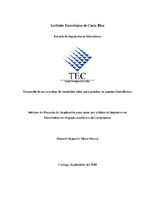| dc.contributor.advisor | Hernández-Rivera, Miguel | es |
| dc.contributor.author | Mora-Orozco, Manuel Alejandro | |
| dc.date.accessioned | 2019-03-13T20:23:15Z | |
| dc.date.available | 2019-03-13T20:23:15Z | |
| dc.date.issued | 2018 | |
| dc.identifier.uri | https://hdl.handle.net/2238/10405 | |
| dc.description | Proyecto de Graduación (Licenciatura en Ingeniería Electrónica) Instituto Tecnológico de Costa Rica, Escuela de Ingeniería Electrónica, 2018 | es |
| dc.description.abstract | This project represents a complement for MPPT algorithms research and testing. The premise of this work is to design a chamber that is able to provide a constant irradiance for testing solar panels. The project was developed for the Laboratory of Electronic Systems for Sustainability (SESLab); the focus of this laboratory is the utilization of electronic systems for the generation, process and efficient use of electric energy harvested from renewable and low environmental impact sources. Currently this laboratory does not have a solar simulator because this technology is too expensive.
The project was divided into two large stages: the first stage was the design and the implementation of the solar simulator, the second stage consisted in the design of a test system that allowed defining the solar simulator's principal characteristics. To design the chamber fire and high temperature resistant materials were used such as plyrock sheets and a galvanized iron frame. To generate the irradiance a twelve H4 100 W halogen bulb matrix was implemented, three 600 W power supply units feed this matrix. To control the solar simulator an Arduino Mega 2560, this module allows to configure the operation mode of the simulator making the unit fully programmable.
A KC65T 65 W solar panel was used to test the simulator and obtain the I/V and P/V characteristics of the solar panel inside the simulator. Obtained results are beyond expectation, the simulator managed to obtain a maximum irradiance of 342.9001± 0.17% W/m2 in high beam mode (whole matrix in high beam) and a minimum irradiance of 160.0013± 0.89% W/m2 in high beam mode but without a column of halogens on. In addition, a third operation mode named low beam mode (whole matrix in low beam) generated partial shading over the panel thus causing maximum power local maxima on the P/V curve. Every test was conducted five times to obtain the standard deviation and type A uncertainty for the maximum power point, the obtained uncertainty is less than 0.5% for every operation mode of the solar simulator. | es |
| dc.language.iso | spa | es |
| dc.publisher | Instituto Tecnológico de Costa Rica | es |
| dc.rights | acceso abierto | es |
| dc.subject | Simuladores | es |
| dc.subject | Paneles solares | es |
| dc.subject | Energía renovable | es |
| dc.subject | Recursos renovables | es |
| dc.subject | Desviación estándar | es |
| dc.subject | Incertidumbre | es |
| dc.subject | Research Subject Categories::TECHNOLOGY::Electrical engineering, electronics and photonics::Electronics | es |
| dc.title | Desarrollo de un prototipo de simulador solar para pruebas en paneles fotovoltaicos | es |
| dc.type | proyecto fin de carrera | es |


